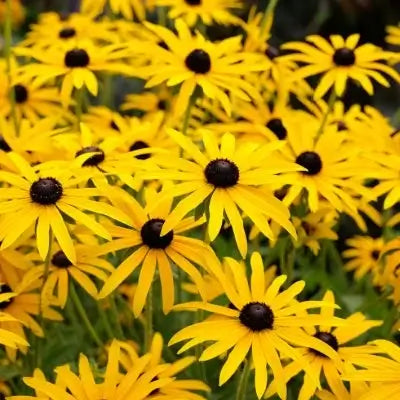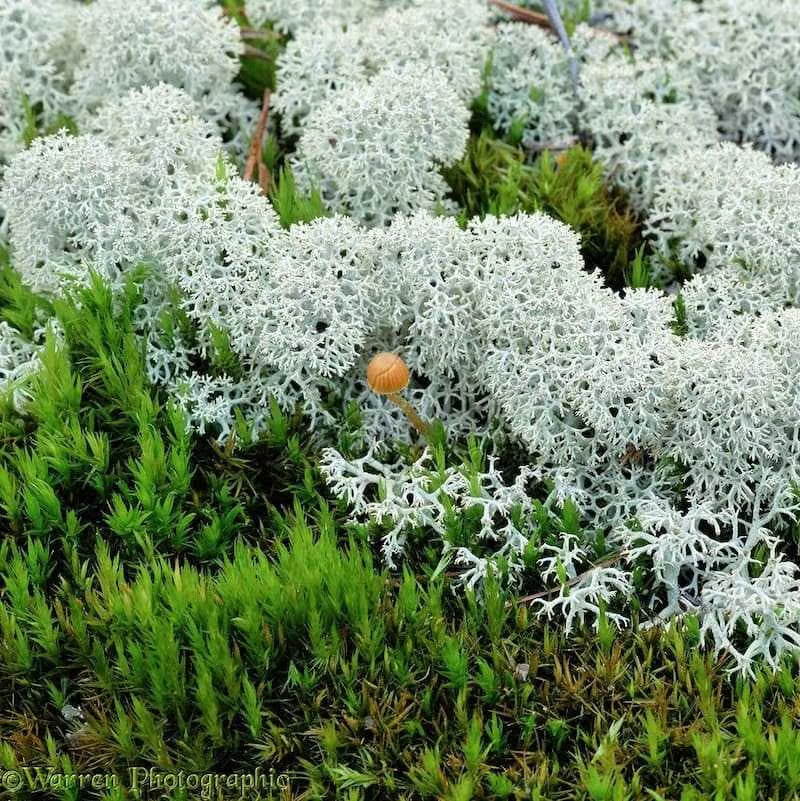
Perennials
Attracts wildlife like birds and insects
Helps with soil erosion control
Adds unique texture and color
Thrives in
ZONE 3ZONE 4ZONE 5ZONE 6ZONE 7ZONE 8ZONE 9Planting Season:
Year-RoundReindeer moss is not a moss but a type of lichen belonging to the Cladonia genus. It is a primary food source for reindeer and caribou, especially during winter months when other vegetation is scarce.
It gets its name from its unique shape. The moss has a branching, bushy structure which resembles a reindeer's antlers. It forms dense, cushiony clumps that can create a soft, cloud-like effect in the garden.
Gardeners can find this lichen in a variety of shades. Bright gray varieties are reminiscent of this beautiful lichen's arctic origin. Other available colors include white, cream, yellow-gray, and yellow-green.
It can add depth to any landscaping project. The lichen creates a variety of stunning colors and textures. When it is wet, it feels soft and spongy. The green base appears bold and vibrant. As the lichen dries, the texture changes to brittle and scaly.
Its distinctive form and texture add graphic interest to indoor and outdoor spaces. The lichen can make urban projects like green roofs and living walls more visually appealing.
You can use it as a ground cover in shaded, well-drained garden areas. Avoid using it in high-traffic areas, as trampling easily damages it. It can be placed around stepping stones or between flagstones to add a soft, natural accent to pathways.
It can be used instead of traditional moss in Zen gardens. Its light, airy texture contrasts nicely with gravel, sand, and stone arrangements. It can also be used in bonsai landscapes to create the appearance of miniature shrubs or ground cover.
The lichen's compact size makes it appropriate for small indoor projects like terrariums - it can thrive in terrariums with good air circulation and moderate humidity. It works well as a decorative element in both open and closed terrariums. Combine it with other lichens, mosses, and small plants to create a lush, miniature landscape.
However, is not moss but lichen with more of a branching habit than mosses and a soft feel to it. And that is why it is so remarkably cold- and drought-tolerant and fuel for reindeer and other herbivores.
It is adapted to the cold regions of the Arctic. It is most often found on clay or soils that are somewhat open and well-sullied of nutrients.
The moss grows at a slow rate of 3-5 mm per annum. It is regarded as a sensitive species in its natural habitat.
It is preserved with glycerin and non-toxic dyes so as to retain its soft touch and bright color. Synthetic moss is normally packaged for ornaments, that is, they do not need water and light for them to survive.
Reindeer moss species are among the slow-growing plants of their kind, but special care has to be provided for them to attain healthier growth rates. It should be grown in cool conditions with adequate drainage, moderate humidity, and indirect light. Heavy foot traffic or frequent disturbance should be avoided.

Height at Maturity
Under 6 Inches
Care
Reindeer Moss thrives in well-drained soil with moderate moisture. It benefits from occasional watering but should not be waterlogged. Avoid direct sun to prevent drying out. Keep it in a cool, shaded area to maintain its vibrant color and texture.
Plant Reproduction
Reindeer Moss spreads through spores and fragmentation of its thallus.
Choose early spring or fall when the soil is moist and cool to plant healthy bare-root ferns. You can also use dormant plants to grow year-round. When you arrive, please soak the roots in water for several hours to rehydrate them. Ferns thrive in moist and shaded areas. Dig a hole wide and deep enough to spread out the roots comfortably. Position the fern so the crown (where the roots meet the fronds) is just at or slightly below ground level. Gently backfill with soil firmly around the roots, and thoroughly water to settle the soil and eliminate air pockets. Apply a 2-3 inch layer of mulch for weed control and to retain moisture, ensuring the mulch does not touch the crown. Water during dry periods is used to keep soil moist but not soggy. Avoid fertilizing in the first year, as ferns prefer nutrient-rich soil over direct fertilization.
Shipping date depends on the date displayed and chosen when you order from the product's page.
We only accept returns on plants verified dead. If you think your plants have died, we offer a 1 year warranty, please use use this File a Claim Link to verify dead plants and start with return warranty process.




Unique Texture:
Reindeer Moss adds a distinct, fluffy texture to any arrangement or terrarium, creating a visually interesting element.
Natural Charm:
Its natural, woodland appearance brings a touch of nature indoors, enhancing the aesthetic of your home or office.
Long-Lasting:
Reindeer Moss retains its appearance over time without wilting or drying out, ensuring lasting beauty in your decorations.
Versatile Use:
Perfect for craft projects, floral arrangements, and terrariums, this moss adapts well to various creative applications
Caring Tips
Each box contains detailed care instructions and information about your product. But here's the basics.
Care Tips
Reindeer Moss thrives in well-drained soil with moderate moisture. It benefits from occasional watering but should not be waterlogged. Avoid direct sun to prevent drying out. Keep it in a cool, shaded area to maintain its vibrant color and texture.
Light Requirements
Reindeer Moss thrives in bright, shady light. It favors a spot with filtered sunlight or dappled shade, as it can get scorched in direct sunlight. Ideal light conditions mimic its natural environment of open woodlands and arctic tundra.
Hardy Planting Zones
3 • 4 • 5 • 6 • 7 • 8 • 9

The soothing green colors and soft textures create a calming atmosphere.
Bring a touch of nature indoors, perfect for urban settings.
The soothing green colors and soft textures create a calming atmosphere.
The soothing green colors and soft textures create a calming atmosphere.
How often should I water my plants?
How do I know if my plant is getting too much or too little sunlight?
What should I do to prepare my plants for winter?
What are the signs that my plant needs fertilizing?
How can I prevent pests from damaging my plants?
How do I choose the right plant for my climate zone?